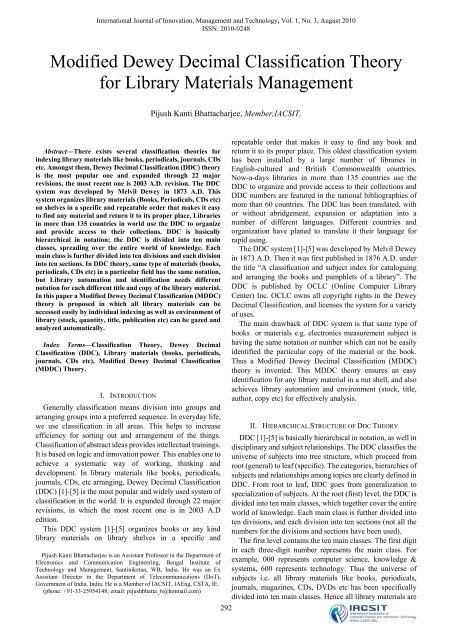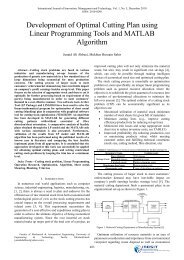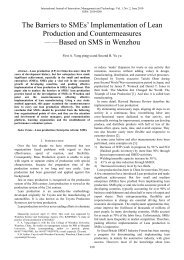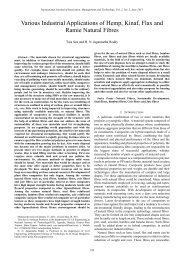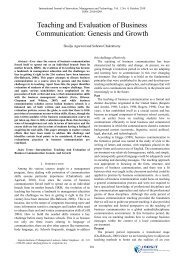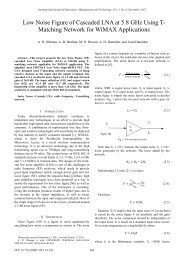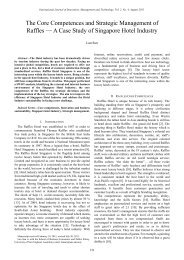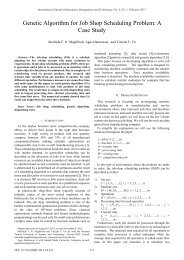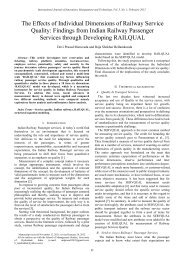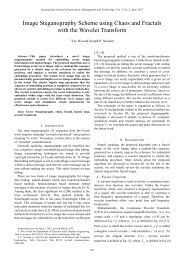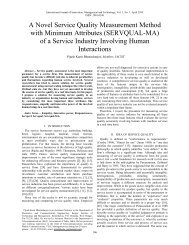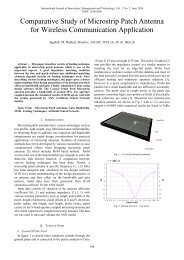Modified Dewey Decimal Classification Theory for Library ... - ijimt
Modified Dewey Decimal Classification Theory for Library ... - ijimt
Modified Dewey Decimal Classification Theory for Library ... - ijimt
You also want an ePaper? Increase the reach of your titles
YUMPU automatically turns print PDFs into web optimized ePapers that Google loves.
International Journal of Innovation, Management and Technology, Vol. 1, No. 3, August 2010ISSN: 2010-0248<strong>Modified</strong> <strong>Dewey</strong> <strong>Decimal</strong> <strong>Classification</strong> <strong>Theory</strong><strong>for</strong> <strong>Library</strong> Materials ManagementPijush Kanti Bhattacharjee, Member,IACSIT,1Abstract—There exists several classification theories <strong>for</strong>indexing library materials like books, periodicals, journals, CDsetc. Amongst them, <strong>Dewey</strong> <strong>Decimal</strong> <strong>Classification</strong> (DDC) theoryis the most popular one and expanded through 22 majorrevisions, the most recent one is 2003 A.D. revision. The DDCsystem was developed by Melvil <strong>Dewey</strong> in 1873 A.D. Thissystem organizes library materials (Books, Periodicals, CDs etc)on shelves in a specific and repeatable order that makes it easyto find any material and return it to its proper place. Librariesin more than 135 countries in world use the DDC to organizeand provide access to their collections. DDC is basicallyhierarchical in notation; the DDC is divided into ten mainclasses, spreading over the entire world of knowledge. Eachmain class is further divided into ten divisions and each divisioninto ten sections. In DDC theory, same type of materials (books,periodicals, CDs etc) in a particular field has the same notation,but <strong>Library</strong> automation and identification needs differentnotation <strong>for</strong> each different title and copy of the library material.In this paper a <strong>Modified</strong> <strong>Dewey</strong> <strong>Decimal</strong> <strong>Classification</strong> (MDDC)theory is proposed in which all library materials can beaccessed easily by individual indexing as well as environment oflibrary (stock, quantity, title, publication etc) can be gazed andanalyzed automatically.Index Terms—<strong>Classification</strong> <strong>Theory</strong>, <strong>Dewey</strong> <strong>Decimal</strong><strong>Classification</strong> (DDC), <strong>Library</strong> materials (books, periodicals,journals, CDs etc), <strong>Modified</strong> <strong>Dewey</strong> <strong>Decimal</strong> <strong>Classification</strong>(MDDC) <strong>Theory</strong>.I. INTRODUCTIONGenerally classification means division into groups andarranging groups into a preferred sequence. In everyday life,we use classification in all areas. This helps to increaseefficiency <strong>for</strong> sorting out and arrangement of the things.<strong>Classification</strong> of abstract ideas provides intellectual trainings.It is based on logic and innovation power. This enables one toachieve a systematic way of working, thinking anddevelopment. In library materials like books, periodicals,journals, CDs, etc arranging, <strong>Dewey</strong> <strong>Decimal</strong> <strong>Classification</strong>(DDC) [1]-[5] is the most popular and widely used system ofclassification in the world. It is expanded through 22 majorrevisions, in which the most recent one is in 2003 A.Dedition.This DDC system [1]-[5] organizes books or any kindlibrary materials on library shelves in a specific andPijush Kanti Bhattacharjee is an Assistant Professor in the Department ofElectronics and Communication Engineering, Bengal Institute ofTechnology and Management, Santiniketan, WB, India. He was an ExAsssitant Director in the Department of Telecommunications (DoT),Government of India, India. He is a Member of IACSIT, IAEng, CSTA, IE.(phone: +91-33-25954148; email: pijushbhatta_6@hotmail.com)292repeatable order that makes it easy to find any book andreturn it to its proper place. This oldest classification systemhas been installed by a large number of libraries inEnglish-cultured and British Commonwealth countries.Now-a-days libraries in more than 135 countries use theDDC to organize and provide access to their collections andDDC numbers are featured in the national bibliographies ofmore than 60 countries. The DDC has been translated, withor without abridgement, expansion or adaptation into anumber of different languages. Different countries andorganization have planed to translate it their language <strong>for</strong>rapid using.The DDC system [1]-[5] was developed by Melvil <strong>Dewey</strong>in 1873 A.D. Then it was first published in 1876 A.D. underthe title “A classification and subject index <strong>for</strong> cataloguingand arranging the books and pamphlets of a library”. TheDDC is published by OCLC (Online Computer <strong>Library</strong>Center) Inc. OCLC owns all copyright rights in the <strong>Dewey</strong><strong>Decimal</strong> <strong>Classification</strong>, and licenses the system <strong>for</strong> a varietyof uses.The main drawback of DDC system is that same type ofbooks or materials e.g. electronics measurement subject ishaving the same notation or number which can not be easilyidentified the particular copy of the material or the book.Thus a <strong>Modified</strong> <strong>Dewey</strong> <strong>Decimal</strong> <strong>Classification</strong> (MDDC)theory is invented. This MDDC theory ensures an easyidentification <strong>for</strong> any library material in a nut shell, and alsoachieves library automation and environment (stock, title,author, copy etc) <strong>for</strong> effectively analysis.II. HIERARCHICAL STRUCTURE OF DDC THEORYDDC [1]-[5] is basically hierarchical in notation, as well indisciplinary and subject relationships. The DDC classifies theuniverse of subjects into tree structure, which proceed fromroot (general) to leaf (specific). The categories, hierarchies ofsubjects and relationships among topics are clearly defined inDDC. From root to leaf, DDC goes from generalization tospecialization of subjects. At the root (first) level, the DDC isdivided into ten main classes, which together cover the entireworld of knowledge. Each main class is further divided intoten divisions, and each division into ten sections (not all thenumbers <strong>for</strong> the divisions and sections have been used).The first level contains the ten main classes. The first digitin each three-digit number represents the main class. Forexample, 000 represents computer science, knowledge &systems, 600 represents technology. Thus the universe ofsubjects i.e. all library materials like books, periodicals,journals, magazines, CDs, DVDs etc has been specificallydivided into ten main classes. Hence all library materials are
International Journal of Innovation, Management and Technology, Vol. 1, No. 3, August 2010ISSN: 2010-0248grouped in these ten main classes as described in DDC theorymentioned below:1) 000 – Computer science, in<strong>for</strong>mation & general works2) 100 – Philosophy and psychology3) 200 – Religion4) 300 – Social sciences5) 400 – Language6) 500 – Science (including mathematics)7) 600 – Technology8) 700 – Arts and recreation9) 800 – Literature10) 900 – History, geography, and biographyAs the notation consists of at least three digits, the fullnumber <strong>for</strong> the main class 6 is 600. Also a complete span ofeach main class consists of 100 three digited numbers e.g.600-699 <strong>for</strong> Technology area.The second level contains the hundred divisions. Thesecond digit in each three-digit number indicates the division.For example, 600 is used <strong>for</strong> general study on technology,610 <strong>for</strong> medicine and health, 620 <strong>for</strong> engineering and alliedoperations, 630 <strong>for</strong> agriculture, 640 <strong>for</strong> home & familymanagement, 650 <strong>for</strong> management & auxiliary services, 660chemical engineering.The third level contains the thousand sections. The thirddigit in each three-digit number indicates the section. Thus,660 is used <strong>for</strong> general study on chemical engineering, 661<strong>for</strong> industrial chemicals, 662 <strong>for</strong> explosives, fuels & relatedproducts, 663 <strong>for</strong> beverage technology.A decimal point follows the third digit in a class number,after which division by ten continues to the specific degree ofclassification needed. A subject may appear in more than onediscipline.For example,600 Technology620 Engineering & allied operations621 Applied physics621.3 Electrical and Electronics Engineering621.38 Electronics Engineering621.381 Microelectronics621.3815 Electronics Devices and CircuitSo, the notation of a book titled Electronic Devices andCircuit <strong>Theory</strong> written by Robert L. Boylestad and LouisNashelsky, published by Prentice-Hall of India Pvt. Ltd is621.3815. Also all books under Electronics Devices andCircuits are consisting of same notation i.e. 621.3815.By DDC conventional notation theory [1]-[5], one can notknow in a particular notation how many different type ofbooks are having in a library and also not able to identify howmany copies of a particular book are in a library stock andremaining outside the library i.e. issued. Since this DDCtheory is unable to establish clear notation and idea <strong>for</strong> librarymaterials (books, periodicals, CDs etc) indexing in view ofdifferent type of books available <strong>for</strong> any area (subject) and<strong>for</strong> stock analysis also. There<strong>for</strong>e a <strong>Modified</strong> <strong>Dewey</strong> <strong>Decimal</strong><strong>Classification</strong> (MDDC) theory is proposed in this paperwhich becomes highly suitable <strong>for</strong> any sorts of library(manual or computerized) materials (books, periodicals,journals, soft copy-CD, DVD etc) <strong>for</strong> all sorts of transactions.In this modified theory MDDC, one can easily search outparticular library material i.e. book, periodical, CD etc andstock verification can be done swiftly.III. MAJOR DRAWBACKS IN DDC CLASSIFICATIONIn DDC classification theory, same type of materials(books, periodicals, CDs etc) in a specified field has the samenotation. It creates a problem in library automation. <strong>Library</strong>automation needs different notation <strong>for</strong> each different title.Also in DDC different books or materials in same field havethe same notation i.e. number. For example, 621.3815 is used<strong>for</strong> notation of Electronic Devices and Circuit <strong>Theory</strong> byRobert L. Boylestad, Louis Nashelsky, Prentice-Hall of IndiaPrivate Ltd, New Delhi, 2005 as well as Electronics CircuitsBy V. K. Mehata, 2007, also all other books under categoryof Electronics Devices and Circuit.IV. PROPOSED MODIFIED DDC TECHNIQUE FORCLASSIFICATION THEORYIn the proposed <strong>Modified</strong> <strong>Dewey</strong> <strong>Decimal</strong> <strong>Classification</strong>(MDDC) technique, first of all I am using approach ofclassification as described in the DDC method. In addition tothe DDC technique, I add other three entities. The first entityis first three letters of the surname of the first author of a bookor first three letters of the name (where the first author is nothaving any surname) of the first author e.g. MAL of Malvino,KAN of Kang etc. In case of Periodicals, Journals,Magazines, CDs etc, the first entity is taken as the threeletters of the surname or name (where there is no surname) ofthe first Editor or the publisher’s name where there is noEditor in person. The second entity is the first letter of thematerial’s (books, periodicals etc) title or name e.g. I ofIntegral, E of Electronic etc. The second entity is proceedingeither putting a slash (/) or dot (.) after the first entity. Thethird entity is the number of copy <strong>for</strong> a particular bookexpressed in figure after putting a slash or dot from thesecond entity i.e. 5 <strong>for</strong> a book means that the copy number <strong>for</strong>that particular book is 5 th . So, when this 5 th copy of this bookwill be issued, the librarian can easily note that 5 th copy ofthat particular book is outside and also in original stockconsists of 5 numbers of that category book. Now combiningthe proposed three entities with existing DDC technique,modified DDC (MDDC) technique is consisting of DDCnotation first, then after giving a space or new line threeentities are appeared e.g. a book titled MicrolectronicCircuits written by A. S. Sedra and K. C. Smith published byOx<strong>for</strong>d University Press, copy number 15 th in a library, isexpressed by modified DDC technique like 621.381SED/M/15. Few more examples are shown below usingmodified DDC technique (MDDC) <strong>for</strong> indexing librarymaterials like books, periodicals, journals, CDs etc.1) Electronic Devices and Circuit <strong>Theory</strong> by Robert L.Boylestad and Louis Nashelsky of Prentice-Hall of IndiaPvt Ltd, 2007, 23 rd copy: 621.3815 BOY/E/232) A Course in Electrical and Electronic Measurements andInstrumentation by A. K. Sawhney of Dhanpat Rai &Company Pvt. Ltd, 2005, 9 th Copy: 621.37 SAW/C/93) Fundamentals of Financial Management by James C.293
International Journal of Innovation, Management and Technology, Vol. 1, No. 3, August 2010ISSN: 2010-0248Van Horne, John M. Wachowicz, JR. of PearsonEducation Ltd, 2007, 12 th copy: 658.15 VAN/F/12In above examples of (ii) and (iii), it is shown that <strong>for</strong>second entity in proposed MDDC technique, if the first wordor first few words are common words (A, An, The,Fundamentals, Of, On etc), the first character of the secondword or first uncommon word from the title is taken <strong>for</strong>second entity.V. CONCLUSIONIntroducing this <strong>Modified</strong> DDC (MDDC) technique wecan arrange library materials like books, periodicals, CDs etcon library shelves in a specific and repeatable order withreturning it to its proper place, and also at the same time wehave a clear picture about a particular book. We can easily go<strong>for</strong> library automation and upgradation by implementing this<strong>Modified</strong> <strong>Dewey</strong> <strong>Decimal</strong> <strong>Classification</strong> (MDDC) technique.There<strong>for</strong>e this MDDC theory enlightens library materialsindexing and management in a perfect way. Practically itidentifies a new direction in the horizon of library materialsmanagement in real time basis.REFERENCES[1] K. Kumar, <strong>Theory</strong> of <strong>Classification</strong>, Vikash Publishing House, Fourthedition, 2009.[2] M. Heiner-Freiling and P. Landry, “The use of the <strong>Dewey</strong> <strong>Decimal</strong><strong>Classification</strong> (DDC) <strong>for</strong> the organization of national bibliographics:Switzerland and Germany/Austria”, IFLA General Conference andCouncil, Oslo, Norway, 2005.[3] http://www.oclc.org/dewey/default.htm[4] http://sunzi1.lip.hku.hk/hkjo/view/6/600146.pdf[5] http://www.library.illinois.eduDr. Pijush Kanti Bhattacharjee is associated with thestudy of Engineering, Management, Law,Indo-Allopathy, Herbal, Homeopathic and Yogicmedicines. He is having qualifications ME, MBA,MDCTech, AMIE, BSc, BA, LLB, BIASM, CMS, PET,EDT, FWT, DATHRY, BMus, KOVID, DH, ACE,FDCI etc. He worked in Department ofTelecommunications (DoT), Govt. of India, as anEngineer from June 1981 to Jan 2007 (26 years), lastlyholding Assistant Director post at RTEC [ER], DoT, Kolkata, India.Thereafter, he worked at IMPS College of Engineering and Technology,Malda, WB, India as an Assistant Professor in Electronics andCommunication Engineering Department from Jan,2007 to Feb,2008 andFeb, 2008 to Dec, 2008 at Haldia Institute of Technology, Haldia, WB, India.In Dec, 2008 he joined at Bengal Institute of Technology and Management,Santiniketan, WB, India in the same post and department. He has written twobooks “Telecommunications India” & “Computer”. He is a Member of IE,ISTE, IAPQR, IIM, India; CSTA, USA; IACSIT, Singapore & IAENG,Hongkong. His research interests are in Mobile Communications, NetworkSecurity, Management, In<strong>for</strong>mation Science, Nanotechnology, VLSI etc.294


